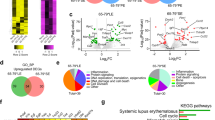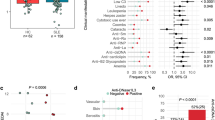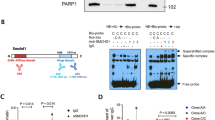Abstract
Most patients with rheumatoid arthritis express particular HLA–DR alleles. The DRβI chains of these alleles share a highly homologous amino acid motif, in their third hypervariable (HV3) region, and this motif seems to help the development of rheumatoid arthritis via unknown mechanisms. In an attempt to identify a ligand of this motif, we screened bacterial proteins. HV3 peptides from HLA–DRB1 alleles containing a QKRAA or RRRAA motif bound the 70–kD heat shock protein (HSP) from Escherichia coli, dnaK. Inlymphoblastoid cells homozygous for these same HLA–DRB1 alleles the constitutive 70–kD HSP, HSP73, that targets selected proteins to lysosomes coprecipitated with HLA–DR. Thus, the QKRAA and RRRAA amino acid motifs of HLA–DR mediate binding of HLA–DR to HSP73. This property may influence the intracellular route, processing or peptide associations of the HLA–DRβ1 chain in these two rheumatoid arthritis–associated alleles.
This is a preview of subscription content, access via your institution
Access options
Subscribe to this journal
Receive 12 print issues and online access
$209.00 per year
only $17.42 per issue
Buy this article
- Purchase on Springer Link
- Instant access to full article PDF
Prices may be subject to local taxes which are calculated during checkout
Similar content being viewed by others
References
Gregersen, P.K., Silver, J. & Winchester, R.J. The shared epitope hypothesis: An approach to understanding the molecular genetics of susceptibility to rheumatoid arthritis. Arthritis Rheum. 30, 1205–1213 (1987).
Stastny, P. Association of the B-Cell alloantigen DRw4 with rheumatoid arthritis. N. Engl. J. Med. 298, 869–871 (1978).
Boki, K. et al. HLA class II sequence polymorphisms and susceptibility to rheumatoid arthritis in Greeks. Arthritis Rheum. 35, 749–755 (1992).
Willkens, R., Nepom, G., Marks, C., Nettles, J. & Nepom, B. Association of HLA-Dwl6 with rheumatoid arthritis in Yakima Indians. Arthritis Rheum. 34, 43–47 (1991).
Ollier, W. & Thomson, W. Population genetics of rheumatoid arthritis. Rheum. Dis. Clin. N. Am. 18, 761–785 (1992).
Wucherpfennig, K.W. & Strominger, J. Selective binding of self peptides to disease associated major histocompatibility complex molecules: A mechanism for MHC linked susceptibility to human autoimmune diseases. J. Exp. Med. 181, 1597–1601 (1995).
Weyand, C.M., Oppitz, U., Hicok, K. & Goronzy, J.J. Selection of T Cell receptor Vb elements by HLA-DR determinants predisposing to rheumatoid arthritis. Arthritis Rheum. 35, 990–998 (1992).
Albani, S. et al. Positive selection in autoimmunity: Abnormal immune responses to a bacterial dnaJ antigenic determinant in patients with early rheumatoid arthritis. Nature Med. 1, 448–452 (1995).
Roudier, J. et al. Tolerance to a self peptide from the third hypervariable region of the Eβs chain. Eur. J. Immunol. 21, 2063–2067 (1991).
Salvat, S. et al. Tolerance to a self peptide from the third hypervariable region of HLA-DRB1*0401 in rheumatoid arthritis patients and normal subjects. J. Immunol. 153, 5321–5329 (1994).
Weyand, C.M., McCarthy, T. & Goronzy, J.J. Correlation between disease phenotype and genetic heterogeneity in rheumatoid arthritis. J. Clin. Invest. 95, 2120–2126 (1995).
Bardwell, J.C. & Craig, E. Major heat shock gene of Drosophila and the Escherichia coli heat inducible dnaK gene are homologous. Proc. Natl. Acad. Sci. USA 81, 848–852 (1984).
Bardwell, J.C. et al. The nucleotide sequence of the Escherichia coli K12 dnaJ+ gene: A gene that encodes a heat shock protein. J. Biol. Chem. 261, 1782–1785 (1986).
Silver, P. & Way, J. Eukaryotic dnaJ homologs and the specificity of Hsp 70 activity. Cell 74, 5–6 (1993).
Cellier, M. F. et al. Cloning and characterization of the BruCella ovis heat shock protein dnaK functionally expressed in Escherichia coli. J. Bacterial. 174, 8032–8042 (1992).
Gomes, S.L., Gober, J. & Shapiro, L. Expression of the Caulobacter heat shock gene dnaK is developmentally controlled during growth at normal temperatures. J. Bacterial. 172, 3051-3059 (1990).
Van Asseldonk, M., Simons, A., Visser, H., de Vos, W.M. & Simons, G. Cloning, nucleotide sequence and regulatory analysis of the Lactococcus lactis dnaJ gene. J. Bacterial. 175, 1637–1644 (1993).
Krishnan, H.B. & Pueppke, S.G. nolC, a Rhizobium fredii gene involved in cultivar-specific nodulation of soybean shares homology with a heat shock gene. Mol. Micmbiol. 3, 737–745 (1991).
Gething, M.J. & Sambrook, J. Protein folding in the Cell. Nature 355, 33–45 (1992).
Terlecky, S., Chiang, H., Olson, T. & Dice, J.F. Protein and peptide binding and stimulation of in vitro lysosomal proteolysis by the 73kDa heat shock cognate protein. J. Biol. Chem. 267, 9202–9209 (1992).
Cresswell, P., ssembly, transport and function of MHC class II molecules. Annu. Rev. Immunol. 12, 259–293 (1994).
Roudier, J., Petersen, J., Rhodes, G.I., Luka, J. & Carson, D.A. Susceptibility to rheumatoid arthritis maps to a T Cell epitope shared by the HI. A-Dw4 DRb 1 chain and the Epstein Barr virus glycoprotein gp110. Proc. Natl. Acad. Sci. USA 86, 5104–5108 (1989).
Houghten, R., Chang, W. & Li, C.H. Human b endorphin. Synthesis and characterization of analogs iodinated and tritiated at residues 1 and 27. Int. J. Pept. Protein Res. 16, 311–315 (1980).
Goyert, S. & Silver, J. Further characterization of HLA-DS molecules: implications for studies assessing the role of human la molecules in Cell interactions and disease susceptibility. Proc. Natl. Acad. Sci. USA 80, 5719–5723 (1983).
Escola, J.M., Grivel, J.C., Chavrier, P. & Gorvel, J.P. Different endocytic compartments are involved in the tight association of class II molecules with processed hen egg lysozyme and ribonuclease A in B Cells. J. Cell Sci. 108, 2337–2345 (1995).
Author information
Authors and Affiliations
Rights and permissions
About this article
Cite this article
Auger, I., Escola, J., Gorvel, J. et al. HLA–DR4 and HLA–DR10 motifs that carry susceptibility to rheumatoid arthritis bind 70–kD heat shock proteins. Nat Med 2, 306–310 (1996). https://doi.org/10.1038/nm0396-306
Received:
Accepted:
Issue Date:
DOI: https://doi.org/10.1038/nm0396-306
This article is cited by
-
Proteomics analysis of lysine crotonylation and 2-hydroxyisobutyrylation reveals significant features of systemic lupus erythematosus
Clinical Rheumatology (2022)
-
Blocking nuclear export of HSPA8 after heat shock stress severely alters cell survival
Scientific Reports (2018)
-
Anti-Proteus activity of some South African medicinal plants: their potential for the prevention of rheumatoid arthritis
Inflammopharmacology (2014)
-
Expression of heat shock protein receptors on fibroblast-like synovial cells derived from rheumatoid arthritis-affected joints
Rheumatology International (2008)
-
Rheumatoid arthritis is linked to Proteus—the evidence
Clinical Rheumatology (2007)



